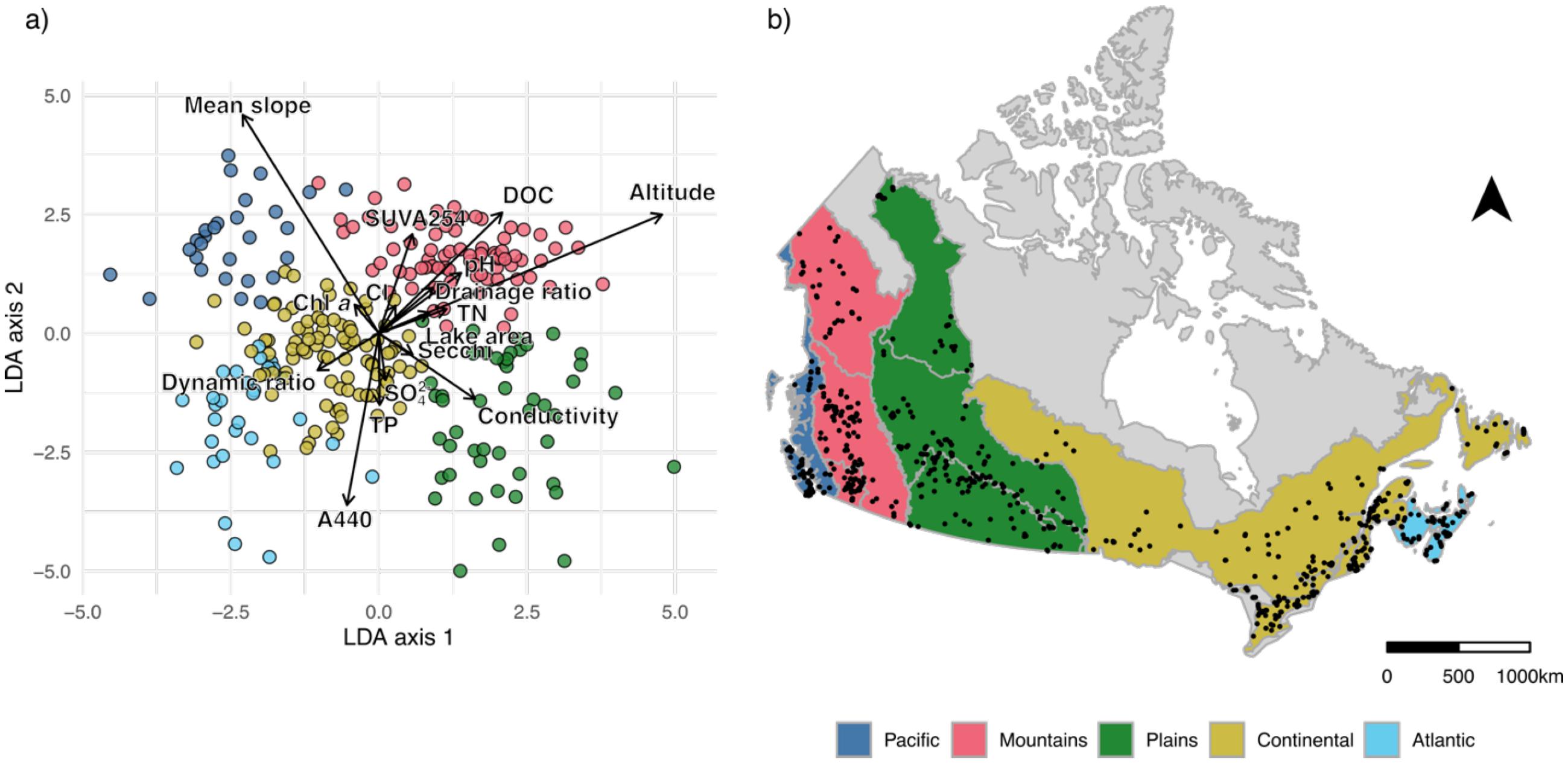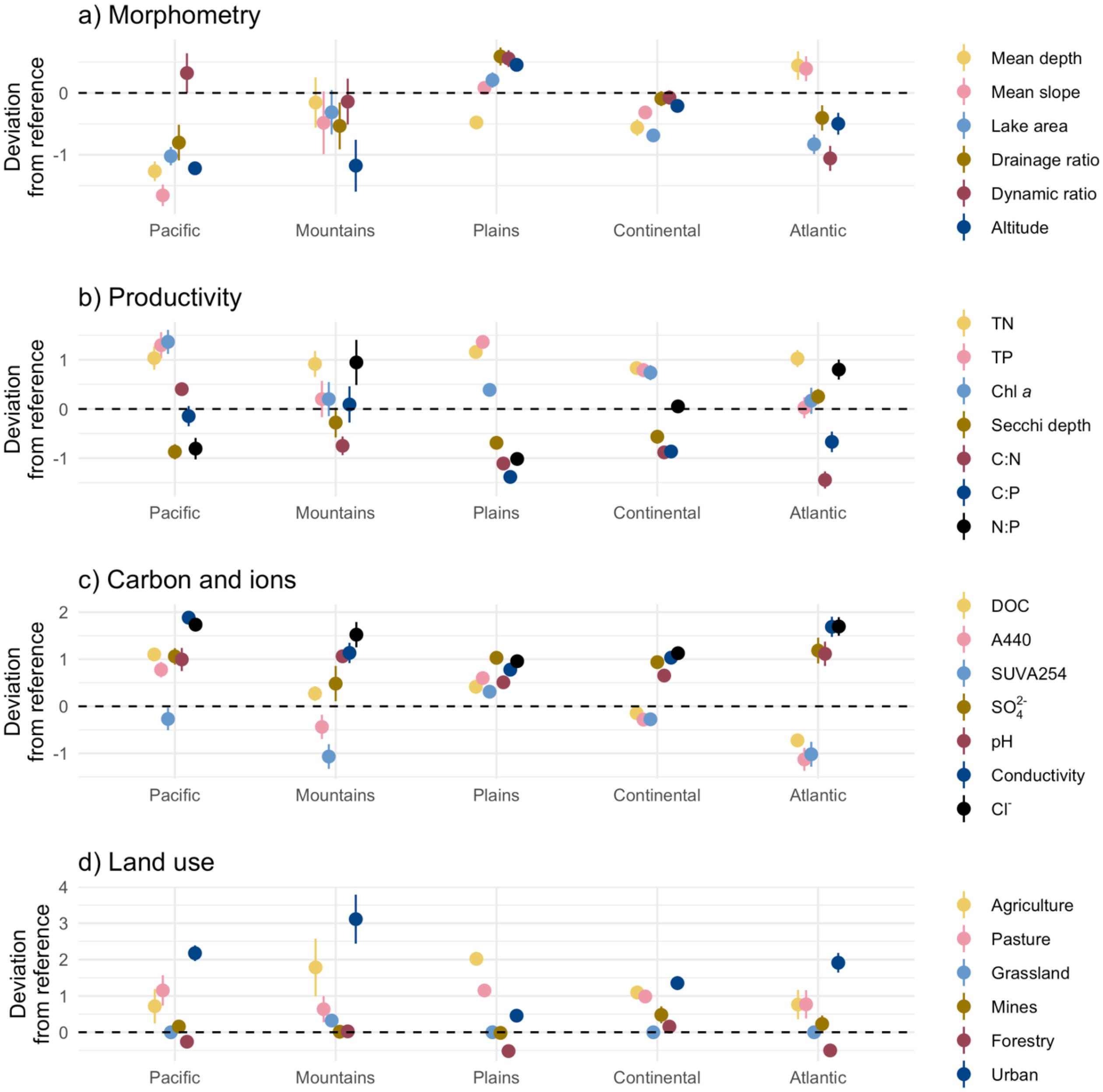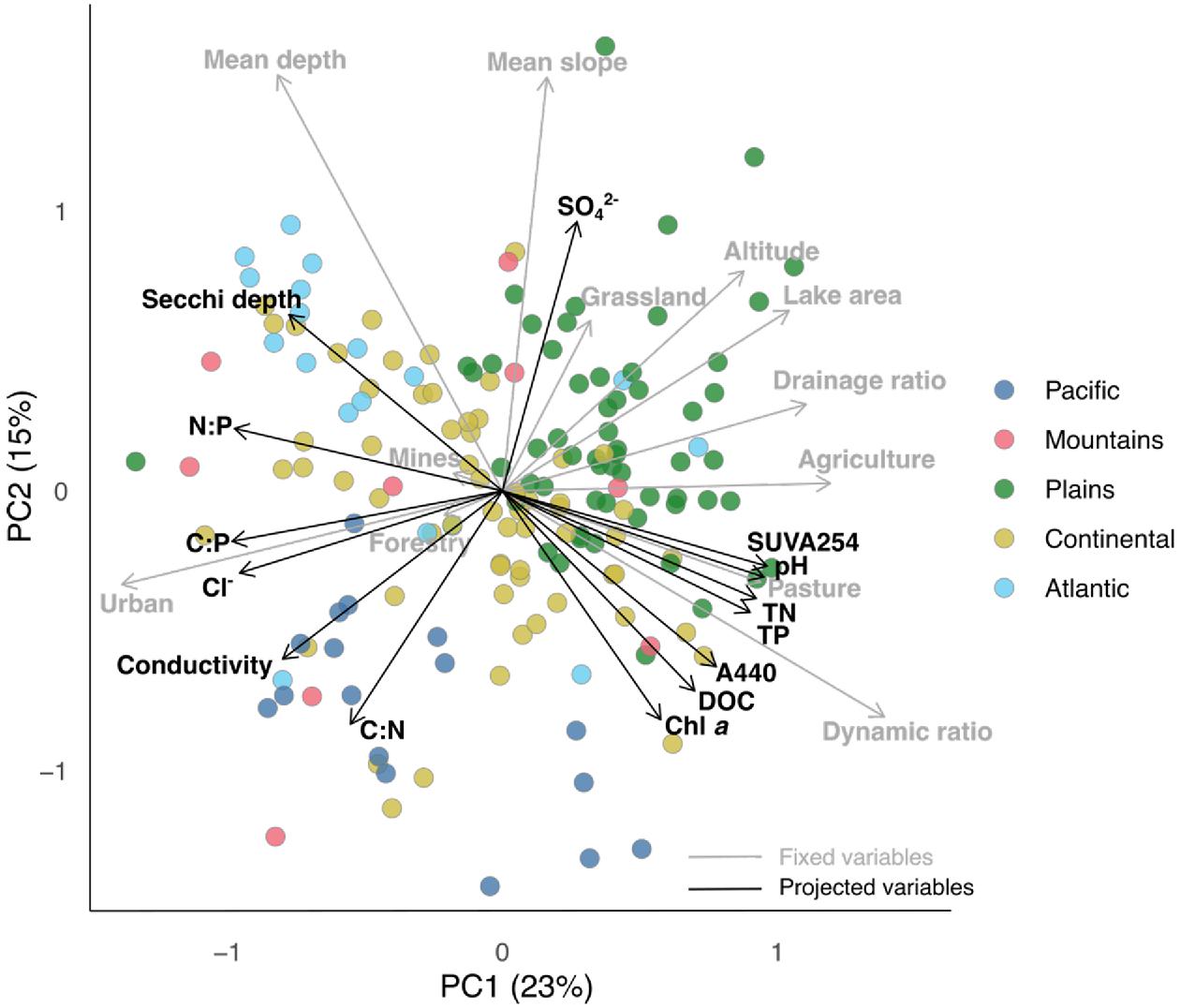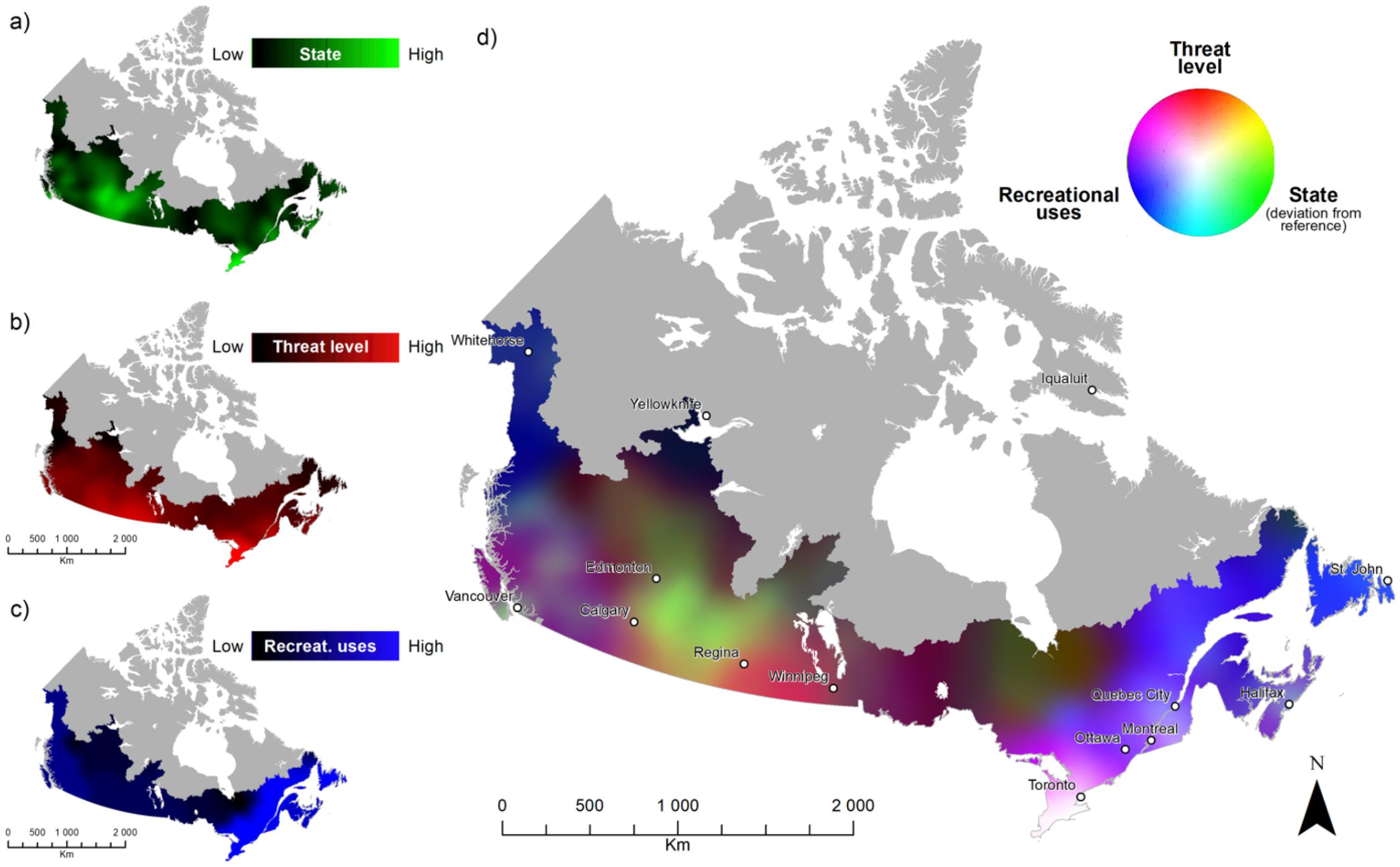In this study, we determined the regionally specific reference conditions of lake ecological state for five lake regions across Canada. Reference conditions were based on shared physical and chemical characteristics of unimpacted lakes from ecozones with the same physiographic properties. With this information, we were able to evaluate how severely impacted lakes, with greater human activities in their watershed deviated from reference conditions, and found two consistent indicators of human altered lake ecological state across Canada: an increase in TN and Cl− concentrations. The ecological state of several lakes determined using these indicators was then geographically linked to two other aspects of the overall lake state, which included future human threats to lakes and recreational ES use. By combining lake ecological state, aquatic ecosystem threats, and ES use in an additive colour scheme, we created the first national social–ecological geography of Canadian lakes. This novel approach allows us to identify areas where lakes are most vulnerable to being altered or losing their capacity to provide ES, and that can serve as priority sites for conservation or restoration to sustain or improve water quality.
Determining lake ecological state: regional references and human indicators of alteration
Understanding how severely a lake is altered by human activities in its watershed requires the knowledge of reference conditions prior to those changes. Spatial differences in the underlying geology that influence the topography, morphometry, and land cover will likely create regionally distinct lake references (
Boyce 2015;
Read et al. 2015), which are essential to characterize when carrying out comparisons at the continental scale (
Cheruvelil et al. 2013). The stratified design of LakePulse sampling, which included a series of low or unimpacted lakes across most of the country, allowed us to determine these reference conditions (
Huot et al. 2019). We found that unimpacted lakes from several Canadian ecozones adjacent to one another with shared physiography had similar morphometric and chemical reference traits. Landscape and watershed characteristics such as elevation and mean slope were the most important variables in discriminating lake properties between regions, followed by conductivity, DOC, and, to a lesser extent, nutrients. This finding highlights the role of physiography in creating lake regions across Canada (
Boyce 2015), suggesting that climate and vegetation type related to ecozones had less of an overall influence on reference lake physical and chemical characteristics.
The deviation of highly impacted lakes from their regional reference allowed us to evaluate which chemical variables were most consistent in capturing a lake's response to anthropogenic changes in its watershed. Most regions behaved as expected and experienced cooccurring higher concentrations of TN, TP, and Chl
a, with reduced Secchi due to increased turbidity (
Minns et al. 2008;
Webster et al. 2008) and land-use changes (
Carpenter et al. 1998;
Nielsen et al. 2012). However, higher TN in impacted lakes was more consistently observed across the lake regions and was not always accompanied by higher TP and Chl
a or transparency loss. Increases in TP, and as a consequence algal biomass, may have been dampened in regions where urban expansion was dominant due to legislative reductions from point-source sewage inputs or well-managed septic systems (
Budd and Jones 1978;
Schindler 2006). One exception was the naturally P-rich region of the Prairies (
Table 2), where, despite a significant increase in both nutrients, the increase in Chl
a was not as marked. This could be explained by a threshold response of Chl
a to increasing TN (
Filstrup et al. 2018). Another possible explanation of why TN was more indicative of human impact in the watershed is the relatively higher applications of N as compared to P fertilizers on agricultural lands (
Glibert et al. 2014;
Goyette et al. 2016) or inputs from atmospheric N deposition (
Elser et al. 2009). Excessive N inputs relative to P in conditions when both are high is cause for concern as higher N:P ratios tend to favour the establishment of more toxic species of algae and cyanobacteria (
Leavitt et al. 2006;
Scott and McCarthy 2010;
Glibert et al. 2014;
Taranu et al. 2017), which impinge on multiple valuable aquatic ES.
Another striking and consistent difference between human-impacted and reference lakes among regions was higher Cl
− concentrations. In northern freshwaters, this increase in Cl
− concentrations is primarily attributed to road salt used for de-icing during winter, which explains why it was most associated with urbanization in the watershed (
Chapra et al. 2009;
Canadian Council of Ministers of the Environment 2011;
Dugan et al. 2017). Regions with the highest road salt use in Canada are Southern Ontario, Quebec, and the Maritimes (
Environment Canada and Health Canada 2001;
Evans and Frick 2001), and salt application is also reported to be high in the Prairies (
Morin et al. 2000), consistent with our observations of altered Cl
− concentrations in these regions (Fig. S5
a). The environmental impact of increased Cl
− concentration in lakes is of growing concern, particularly with changing climate conditions where warmer average winter temperatures and changes in precipitation may require more salt for de-icing (
Kaushal et al. 2021). High levels of Cl
− can have adverse effects on aquatic life, with chronic toxicity occurring at 250 mg/L (
Evans and Frick 2001) and recent experimental work showing adverse effects and shifts in community composition at even lower Cl
- concentrations, highlighting the need to downscale toxicity levels even further (
Hébert et al. 2022;
Hintz et al. 2022). Increased salinization may also impact physical lake properties, including stronger and more prolonged stratification, with cascading repercussions on major biogeochemical cycles (
Kaushal et al. 2005;
Dugan et al. 2017). As such, increased Cl
− concentrations may influence the provisioning of several ES, including sport fishing. However, the overall consequences of increased salinization on lake ecosystem functioning and services remain underexplored. Regardless, Cl
− was the strongest human indicator of urban expansion, whereas TN was both an agricultural and urban indicator. Both TN and Cl
− can render drinking water unpotable due to concerns around human health and taste, respectively (
Kaushal et al. 2005;
Howard and Maier 2007;
Karimi et al. 2020), making their combined deviation a good proxy for assessing the altered lake ecological state and vulnerability to provide different ES.
Beyond the clear patterns of TN and Cl
− increase in impacted lakes, we also found some regional anomalies in the deviations from certain chemical variables. For example, impacted lakes in the Atlantic and mountain regions were clearer than reference lakes on average, with a higher or unchanged Secchi depth. As Chl
a concentrations in impacted lakes were similar to those in reference lakes, this enhanced water clarity could be explained by lower coloured DOC (A440,
Brezonik et al. 2019). A possible influence on this loss in colour is the photobleaching of CDOM, which can increase water transparency (
Del Vecchio and Blough 2002;
Kalff 2002). Overall, lakes from the mountain region are on average deeper and at higher altitudes (
Table 2), whereas impacted Atlantic lakes, morphometrically, tend to be deeper with a lower sediment-dynamic ratio (
Fig. 3). For both, this would result in longer water residence times, favouring photobleaching. Indeed, in terms of morphometric, topographic, and landscape variables, most impacted lakes tended to be near or lower than reference lakes (with the exception of the Plains), but each region has its peculiarities. One overarching tendency is that impacted lakes across multiple regions were more accessible to human populations. This includes impacted Pacific, Mountain, and Atlantic lakes that were at lower altitudes, similar to what has been reported elsewhere (
Ebner et al. 2022). In the case of the Pacific region, impacted lakes had much shallower watershed slopes than unimpacted ones and were presumably easier to develop on. In the Plains, Pacific, and Continental regions, impacted lakes were generally smaller and shallower, making them more vulnerable to changes in the landscape due to higher internal loading and reduced volume (
Nõges 2009). Impacted lakes in the Plains had both higher drainage and dynamic ratios, resulting in a higher proportion of terrestrial inputs (
Kalff 2002) and a greater proportion of the water in contact with sediments (
Håkanson 1982), respectively. These physical features combined could explain the slightly higher colour in the impacted lakes of this specific region, as their physical properties make them inherently more vulnerable to human pressure.
A first social–ecological geography of overall lake state
To create the first social–ecological geography of lakes in southern Canada, we developed an innovative framework that spatially links regional lake ecological state, emerging lake threats, and recreational ES use. By colour-coding ecological and social gradients, the RGB composite map (
Fig. 5) allowed us to visualize hotspots of aquatic ecosystem vulnerability and ES conservation. This approach clearly identified areas where lakes were used by people and where there was a risk of losing recreational ES due to threats or lake degradation. From the perspective of preserving recreational ES, the colours of interest were white (high alteration, threats, and use), cyan (high alteration and use), and magenta (high threats and use), where use coincided with an altered lake state and/or threat. This first broad-scale national attempt suggests that locations expressing these colours should be considered priority areas for restoration or for monitoring as a precaution to ensure ES will not be lost over time.
Through this framework, we found that populated urbanized areas were of greatest concern. The southern tip of Ontario, which includes the Greater Toronto Area and accounts for nearly 20% of the country's population (
Canada Population 2021), appeared in white on the map due to a combination of lakes being intensively altered, threatened, and used. Other areas of concern include the Lower St. Lawrence River between the cities of Montreal and Quebec and the Halifax region in Nova Scotia, which all exhibit a colour approaching light cyan, indicating high recreational use combined with an altered lake ecological state and a moderate threat level. All these urban locations should be monitored, as a degraded lake state could potentially lead to the loss of lake services. The same colour combinations were found in British Columbia around the cities of Vancouver and Victoria. However, according to the data we had, recreational use on the West Coast was lower, which resulted in the altered lake ecological state (in lighter green) emerging as a more prominent component overall. Areas coloured magenta were found in southeastern Ontario, southern Quebec, and the lower part of British Columbia. Here, recreational use and threat levels were high, but lakes, on average, are not yet significantly degraded. As such, management efforts should be implemented now to maintain their current healthy state. Finally, in the Plains, particularly around Saskatoon, Saskatchewan, and Edmonton, Alberta, lakes were altered and threatened by growing agriculture and urbanization, even though recreational ES use is low.
We believe our approach is valuable in identifying priority areas for ES and aquatic ecosystem protection, and the results presented here should be considered a proof of concept. One of the benefits of our proposed framework is that it is very flexible in that it can be applied at different scales of inquiry, with a focus on more regional threats of concern where applicable (for example, mining, logging, or wildfires), and assess the use of different ES than the ones used here. It also provides a striking visual representation that is relatively easy to understand. The approach may be most useful to management and stakeholders at smaller regional or local scales of inquiry, where information on a broader suite of ES valued by local communities may be available or more quantitatively robust. The challenge, perhaps at smaller scales, is assessing the deviation of a lake's ecological condition from baseline. However, the latter could be taken from a broader context of spatial assessment (i.e., the Lake Region presented here), whereas threats and use could be quantified more locally (
Martín-López et al. 2017).
Limits and considerations
One limitation to our study is that our indicators of altered lake ecological state, TN and Cl
−, do not necessarily impinge directly on the delivery of the four recreational services assessed here but may act as a proxy for some. For example,
Health Canada's Guidelines for Canadian Recreational Water Quality (2012) related to swimming have threshold values for cyanobacteria and
E. coli related to the risk to human health in the case of direct contact with skin. High concentrations of TN are known to promote toxic algal and cyanobacterial blooms (
Glibert et al. 2014;
Monchamp et al. 2014;
Taranu et al. 2017) and are indirectly linked to the loss of this ES. Similarly, Cl
− may, through food web effects (
Dugan et al. 2017;
Hintz et al. 2022), influence sport fisheries, although that remains underexplored. A more appropriate ES to assess with nitrate (as part of TN) and Cl
− is the loss of drinking water, as increasing concentrations of both can render water unpotable due to human health concerns and taste, respectively (
Kaushal et al. 2005;
Howard and Maier 2007;
Karimi et al. 2020), but we did not find easily accessible data around that ES across Canada.
There were also several limits to the recreational ES dataset we used. First, it was dated from 1996, and although adjusted for the current population, it is possible that recreational habits have changed over time and no longer accurately reflect current use. Second, the ES dataset covered broad watershed areas across the country and was not as spatially explicit as other components in our model. The recreational ES data were also only available in days of use per square kilometer of major watershed, which reflects the intensity of use over a given area, not the intensity of use by individuals. As such, whether the lakes assessed in Lake Pulse were actually used for these recreational ES is uncertain, although given the proximity of these lakes to roads, chances are more likely. Less densely populated areas are disadvantaged as use could be diluted by watershed size, where a sparsely populated area in which individuals use ES intensively can be equivalent to a densely populated area where individual use is infrequent. Furthermore, many of these sparsely populated areas are inhabited by First Peoples who were not considered in the census; given their intimate relationship with natural resources, we argue the need to prioritize the protection of ES for those nations that rely directly on them for provisioning (
Berkes 1990;
Islam and Berkes 2016).






